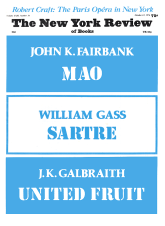In response to:
Bombay: The Skyscrapers and the Chawls from the June 10, 1976 issue
To the Editors:
Friends have brought to my attention an article in the June 10 issue of your review which does great injustice to Ananda Marga, an organization which I represent. Mr. V.S. Naipaul, in his article “Bombay: the Skyscrapers and the Chawls,” writes about the Shiv Sena, a very popular socio-political group in the state of Maharashtra. On page twenty-seven Mr. Naipaul compares the Shiv Sena with Ananda Marga in the following manner:
…infinitely more positive, for instance, than the Anand Marg, “The Way of Peace,” now banned, which preached caste, Hindu spirituality and power through violence, all of this mingled with ritual murder and mutilation and with homosexuality (recruits desired by the leader were persuaded that they were girls in previous lives)….
Like a number of other Indians, it appears Mr. Naipaul has fallen prey to the Indian government’s violent denunciations and false depictions of Ananda Marga. The government’s propaganda campaign against Ananda Marga has been especially vehement since the organization was banned in July of 1975. But the slurs on the name of Ananda Marga began long before the recent “state of emergency.” For several years the government has been claiming that Ananda Marga is a violent, communal organization, although the writings of P.R. Sarkar, founder of Ananda Marga, are filled with calls for a universalistic outlook based on dedicated service. Rather than being in favor of the caste system, as this article states, Mr. Sarkar, in one of his books, called casteism “another manifestation of long standing selfish mentality” Ananda Marga’s strong stand against the caste system provoked resentment from orthodox Hindu leaders who supported such outmoded distinctions.
In the early 1970s India’s central government police, who are under the control of the prime minister, initiated numerous cases against Ananda Marga’s leaders, including Mr. Sarkar. The government claimed that these Ananda Marga leaders conspired to kill former members of the organization. The arrests were accompanied by sensationalistic news reports supplied by government sources. After many years of delays, during which time the prisoners were seriously mistreated, the case has finally come to trial. In spite of statements by Mrs. Gandhi that there is overwhelming evidence of Mr. Sarkar’s guilt, international observers from England and Canada who have been present at the trial have pronounced the government’s case a sham. They have said that the witnesses are unreliable and self-contradictory, most of the prosecution’s evidence is irrelevant, and the defense has little opportunity to present its case: most of the potential defense witnesses are in jail and those that aren’t are afraid to testify for fear of soon ending up there also.
It is not hard to understand why Mrs. Gandhi’s government is trying so hard to suppress Ananda Marga. It was afraid of the popularity and rapid growth of the organization. Ananda Marga’s program of spiritual and social development, carried out by dedicated workers, was in stark contrast to the empty rhetoric of the government. Its call for moral, effective leadership was seen as a threat by the corrupt, incompetent government officials. The government’s attempt to destroy Ananda Marga in India has not stopped the organization from attracting followers in over fifty countries in the world and becoming known in many places for its social service work. So the Indian government continues to spread false and misleading impressions about Ananda Marga wherever they can. Articles like Mr. Naipaul’s, whether written in ignorance of the facts or in complicity with Indian authorities, only serve to perpetuate falsehoods and injure innocent people.
Richard J. Gochal
Director, Ananda Marga
Office of International Affairs
Washington, DC
This Issue
October 14, 1976



